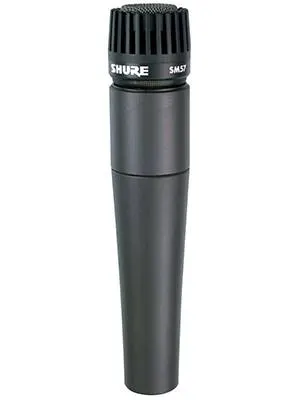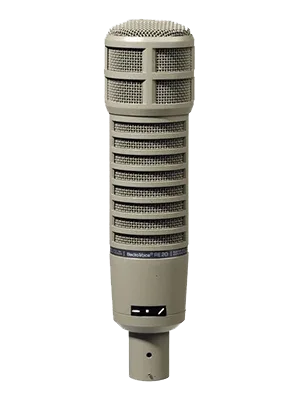The best vocal microphones come in various shapes, sizes, and types. Compound that with the unbelievable amount of bad info out there and it’s no wonder people aren’t sure what they should be looking for. There is a truth to the matter and we’re going to break it down for you simply and clearly. Then we’ll offer some recommendations of both main types of mics in various budget ranges so you can get what you need and move on with recording!
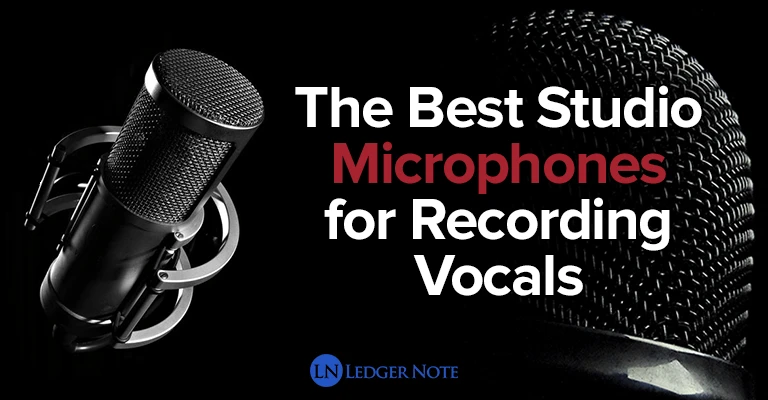
The following review may contain affiliate links which may earn us a small commission when you click on them, at no extra cost for you. As an Amazon Associate we earn from qualifying purchases.
The first thing to realize about a question such as “What’s the best microphone for vocals?” is that there as many types of voices as there are mics.
Beyond that, there are types of vocal performances that may fare better with a dynamic mic instead of a condenser, and vice-versa, even if the mic in the other camp is less good.
With all these considerations, we decided to provide you with info about both dynamics and condensers, what each excel at, and what to consider about your own voice and performance style at the end of this article.
Most of you are here because already know the nitty gritty of different microphones but need an extra hand to actually decide which model to go for. And you are in the right place! Dig into our review and find the best microphone for you!
Need more information in order to better understand your needs and navigate the vast world of microphones? We have got you covered! Visit of FAQs Section
INCLUDED IN THIS GUIDE
| RODE NT1-A | Best Bang for the Buck | Buy on Amazon |
| RODE NTK | Best for its Value | Buy on Amazon |
| AKG C414 XLII | Best to Get all the Pickup Patterns | Buy on Amazon |
| NEUMANN TLM 102 | Best of The Best | Buy on Amazon |
| SHURE SM57 | Best Budget Pick | Buy on Amazon |
| ELECTRO-VOICE RE-20 | Best for Bass Sounds | Buy on Amazon |
| SHURE SM7B | Best Main Vocal Microphone | Buy on Amazon |
We’re going to start with condenser mics, from cheapest to most expensive, and then move to dynamics. There are a million options out there and we can’t possibly cover them all. These are those we have personal experience with that we know are awesome and have universal appeal on many sound sources.
By the way, we don’t recommend buying mics used. That works with most electronics but the tubes and diaphragms here are too sensitive to gamble on it. Play it safe here.
Condenser Microphones
You’re not going to go wrong with a condenser for vocals of any kind. They’ll provide the sensitivity you want to hear all of the subtle details in your performance. They’ll record all the sounds you don’t want sneaking in too! So make sure you’re controlling your environment like cutting off the air conditioner, etc. They are that good!
Word of warning. There a lot of very cheap condensers out there for as low as $25 that look very professional on the surface. Don’t even bother with that nonsense. Our first recommendation is as low as you should go if you want to achieve professional quality.
RODE NT1-A
As far as entry-level professional mics go, I always recommend the Rode NT1-A. There are cheaper ones like the MXL 990 in the Honorable Mentions below, but that’s only higher quality consumer level. The NT1-A is where you get into actual studio quality.
I had some friends release an album they worked on secretly, and when it finally dropped I was floored by the vocals. It had rap and singing and it all sounded fantastic. They told me it was the NT1-A. They used the same interface in the same room as before with the same mixing techniques.
The only variable that changed was the mic. That’s when I got sold on Rode and bought an NTK (the next option) to try and one-up them.
The NT1-A is the anniversary edition to the older NT1 model, proving its longevity and demand. This mic shines on all vocals and especially brings the clarity in the mids and high frequencies. Any home studio should start here if they are constrained by a budget and then move on to upgrading their preamps if they haven’t.
This mic, like all mics, only gets better as you surround it by better equipment. It’s a keeper and will tide you over for years as you improve weaker links in your signal chain.
Specs:
- Type: Condenser
- Pick-up pattern:Cardioid
- Connection: XLR
- Other: wired connectivity
Pros:
- Excellent built quality
- Great value for the price
Cons:
- No pad to fight external noise
RODE NTK
The Rode NTK is my go-to mic for all vocals and any other application except miking a bass amp (I prefer my Oktava MK-319 for that but I’d rather D.I.). I picked this up after hearing the NT1-A as mentioned above. I figured I’d push up a couple models to out-do them in quality. It wasn’t necessarily the nicest thing I ever did, but I definitely stole their shine.
Even on your typical interface and mixer preamps this beast automatically jumps you to pro sound quality. I later paired it with some of the best preamps available and it was so nuts that I’ve never bought another “main” vocal mic again.
I’ve used it on acoustic guitar, grand piano, flutes, saxophone, and even ocarinas. There’s been nothing I’ve thrown at it that it didn’t absolutely shine on.
It’s audio characteristics are what I would call slightly warm due to the awesome tube it comes default with and also crystal clear bright on the upper frequencies especially. I’ve used it for rap on all manner of voices.
I’ve used it on male and female singers, and I’ve especially loved it on the ladies. It captures a sense of air coming through the voices that makes it sound super intimate and realistic, even after pop genre levels of compression. Think sparkle at just the right amounts. Mixing vocals is a piece of cake since switching to the NTK.
I’ll stop gushing over this mic. If you want something that slays vocals like no other in an affordable price range that can capture the beauty of any instrument as well, then I highly suggest you give the NTK a good look-over. Note that this one has an external power supply custom made to power it’s superior electronics.
This mic has literally paid for itself many times over. I’ve had bands seek me out just to track vocals at my studio with this mic. They didn’t know what I was using. They just wanted “that sound.” I attribute it all to this mic.
Specs:
- Type: Cardioid Condenser Mic
- Pick-up pattern: Cardioid
- Connection: XLR
- Other: designed for professional use
Pros:
- Wide dynamic range
- Reasonable price
- Well-designed and engineered
Cons:
- No low-frequency cut switch
- No sturdy carry case
AKG C414 XLII
Among the most versatile and popular vocal mics is the AKG C414 XLII. It’s double the cost of the option above not because it’s that much better, although it is a bit better in raw quality. It’s the options this mic comes with that justifies the price.
What’s unique about this mic is its ability to provide 5 different pickup patterns. For vocals on one person you’ll use the cardioid pattern, which all other mics on this list are set to with no other choices.
Here you can go omnidirectional, figure-8 (awesome for two vocalists at once like seated interviews or duets), and few others. It also features several attenuation pads for gain staging and three low-cut filters and roll-offs.
While most of these mics are universally appealing on almost any source you put it in front of, this one can adapt to almost any situation as well due to these pickup patterns and roll-offs. It’s a great choice if you need one masterful workhorse instead of buying a handful of different mics.
Specs:
- Type: Condenser Mic
- Pick-up pattern: 9 switchable patterns
- Connection: XLR Connector
- Other: wired connectivity
Pros:
- Wide range of functionalities
- Great for all vocal styles
Cons:
- Entry level choice, more professional options available
NEUMANN TLM 102
Anyone even tangentially involved in recording knows the name Neumann. The Neumann TLM 102 is their more financially accessible option, compared to models like their U47 mic that costs as much as a decent car.
While the AKG above was only a small step above my favorite Rode NTK in quality, the TLM 102 is a giant leap. This mic is perfect for the studio that doesn’t want to compromise on vocal quality at all but still thinks spending five-figures on one mic is dumb. This has the five-figure quality of all other Neumann’s at a reasonably marketable price.
This bad boy got it’s reputation not only for looking amazing (which matters when you’re impressing clients) but that it brings the perfection across the entire frequency spectrum. Its frequency response isn’t entirely flat though.
It features a slight bump around the 5 kHz – 6 kHz range, which as all of us mixers know is right where “vocal presence” sits. We almost always boost a bit there, which explains why non-mixers love this mic. That job is already done and contributes to sounding realistic yet larger than life.
This is your best bet in terms of the diminishing returns curve before cost jumps to insane levels with not much return on extra quality. If you can’t match professional albums with this, you need to look at upgrading your preamp and acoustic treatment, because this is as good as it gets in the realm of realistic budgets.
Specs:
- Type: Condenser
- Pick-up pattern: Unidirectional
- Connection: XLR
- Other: high maximum sound pressure level (144 dB), wired connectivity
Pros:
- Compact design
- Great quality for value
Cons:
- No shock mount
Dynamic Microphones
Dynamics are equally capable of producing professional quality vocals. As a matter of fact, one of my all time favorite mics is shown below and is an industry standard for radio personalities where it’s 100% about their voices.
Dynamics typically are more durable and used on stage or in live arenas and can handle higher SPLs than condensers. They also don’t need phantom power for a tube, because there is no tube. Let’s take a look-see.
SHURE SM57
The Shure SM57 is the industry workhorse mic. This is one of those cases where you wonder why the price is so absurdly low on the most widely praised mic ever. It’s brother, the SM58 is the exact same mic with a different capsule on top and gets the same praise. So what gives?
I honestly don’t know and I’m not complaining. Maybe it’s designed to be a loss leader to get you addicted to Shure products. It’s working on most of us. This mic is considered the industry workhorse due to its ability to produce an above average quality on any instrument or voice. Pros use it on vocals, a dozen at a time on drums, electric guitar amps, whatever.
What everyone discovered was that this mic performed at its cost level when surrounded by similarly priced preamps, converters, etc. But when fed into mid-range gear it became a mid-range mic. Same with top of the line gear. It’s almost a chameleon in that sense.
It’s a mic every studio probably has three if not ten of, because it grows along with you as you upgrade other components over time. Lots of live venues like bars use these exclusively because you can beat them all to hell and they never break and keep on sounding great.
It’s your cheapest entry point in the world of dynamics for pro quality that lets you then use more of your future budget on other items, knowing it will improve along with the next piece.
Specs:
- Type: Dynamic
- Pick-up pattern: Unidirectional
- Connection: XLR
- Other: wired connectivity
Pros:
- Great value and easy to use
- Has a great sound quality
Cons:
- There are better options for vocals
ELECTRO-VOICE RE-20
My favorite dynamic on the planet is the Electro-Voice RE-20. This one and the next one are in a battle of “which is the best dynamic ever” and neither can win because it’s about flavor. I happen to like the flavor of the RE-20 for the same reason radio hosts and rappers love it… the proximity effect.
Basically, the closer you place your mouth to this mic, the more bass your voice will take on in a good way. By the time you EQ and compress your vocals, you sound like the most confident, supremely alpha person ever.
You know how radio DJ’s all have “that voice” that sounds thick, deep, and super smooth? This is how they achieve it with this exact mic. It’s how you sound commanding and larger than life, which is perfect for radio and especially rap.
There’s not much more to say! The RE-20 sounds great on all voices and you can snuggle right up against it to unlock its secret weapon. And to top it off, it’s completely reasonably priced. Now that you know what it looks like, you’ll start seeing it everywhere as you watch radio interviews, pro podcast videos, and studio footage.
Specs:
- Type: Dynamic
- Pick-up pattern: Unidirectional
- Connection: 3-pin XLR
Pros:
- Great value and easy to use
- Has a great sound quality
Cons:
- Heavy and bulky built
SHURE SM7B
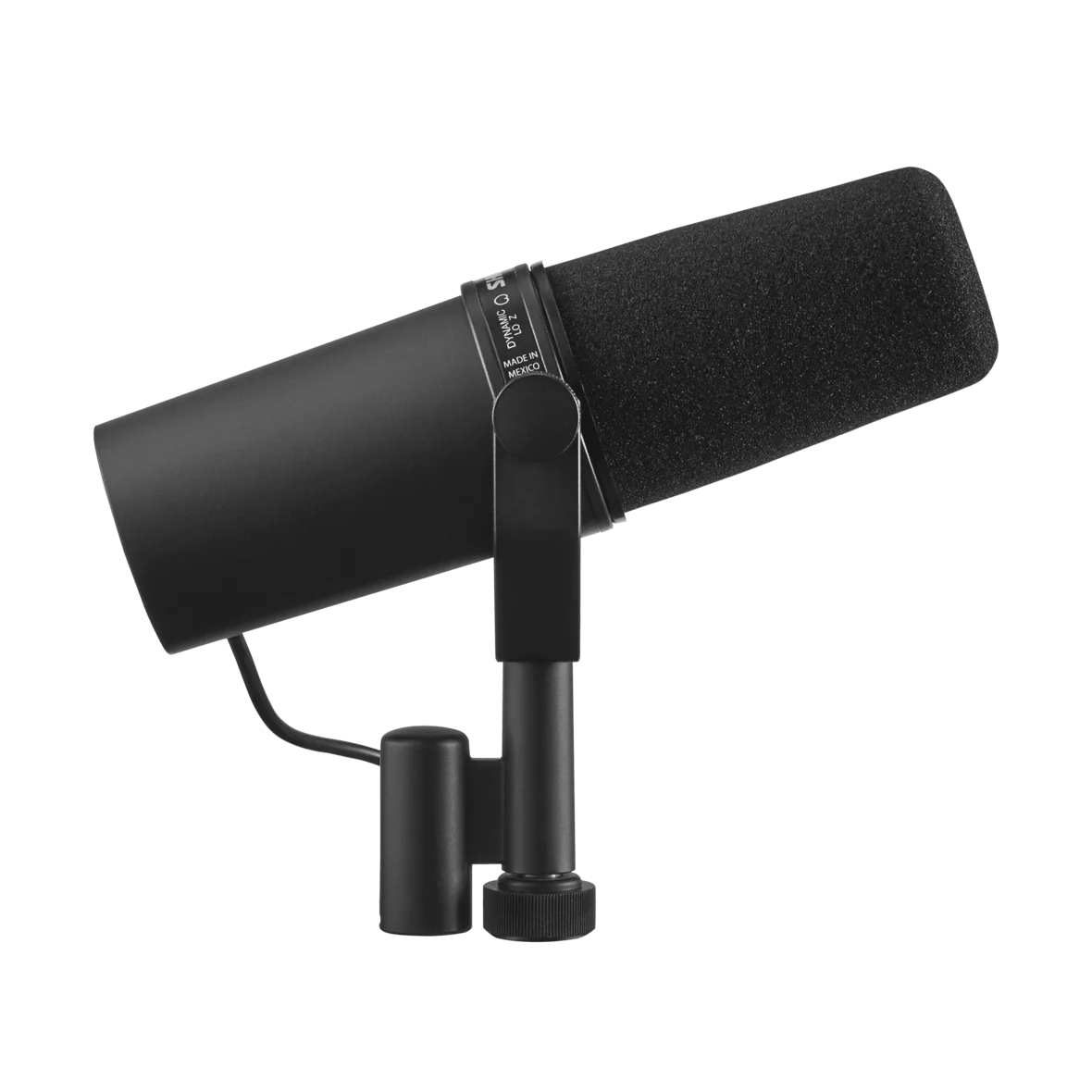
What’s amazing about the Shure SM7B is that not only was it used as the main vocal mic on the world’s best selling album, Thriller by Michael Jackson…
But it’s absolutely affordable even for home studios. Priced the exact same as the RE-20 above, it’s a toss up between which takes the crown as best dynamic. I’d say this one is a bit more universal in appeal. It doesn’t have a secret application in which it shines like the RE-20, but you’d have to absolutely screw up in the mixing to not sound amazing with this bad boy.
One neat feature is that it comes equipped with a custom windscreen designed just for it to not impact the carefully crafted frequency response. This response has a slight presence boost which is always added a bit in the mix for vocals anyways, comes with a shock mount pictured above, and has shielding built in for electrical interference. That’s why a lot of TV and movie studios opt to use this when filming around all their extra lights and cameras.
This is another one of those “What more do I need to say?” scenarios. It was pretty much the exclusive mic used on Thriller and most of Michael Jackson’s other hits. It’s the bomb dot com.
Specs:
- Type: Dynamic
- Pick-up pattern: Unidirectional
- Connection: XLR
Pros:
- Robust and sturdy design
- Warm and comfortable sound
Cons:
- Not recommended for beginners or those on a budget
Honorable Mentions for Best Vocal Microphone
We can’t go on forever mentioning every mic out there but there are several more that deserve some attention if you still want to explore more options. Here are five that all have great utility to offer:
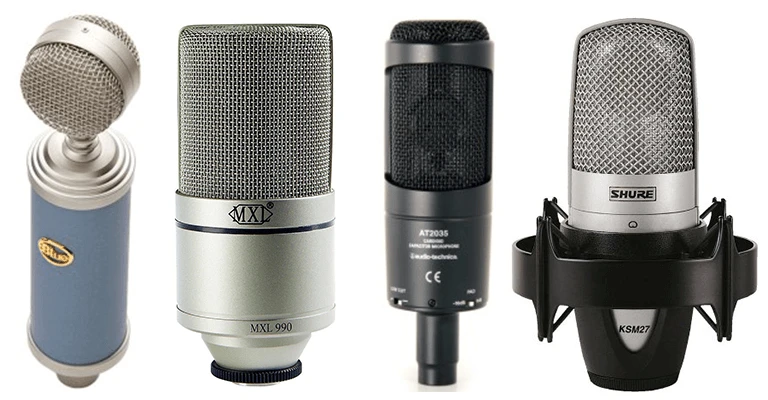
From Left to Right in the picture above:
- Blue Microphones Bluebird (a very transparent condenser when sonic accuracy matters the most)
- MXL 990 (an extremely inexpensive condenser for project and home studios on a tight budget)
- Audio-Technica AT2035 (a great lower priced condenser option just below the Rode NT1-A)
- Shure KSM32 (another top of the line mic used on tons of industry releases for deep voices)
And for fun and not pictured is the Sony C-800G, Dr. Dre’s go-to vocal mic. It got a lot of attention as being his choice for all of the 50 Cent records. It’s so expensive that it’s one of those products people think it’s funny to leave fake & silly reviews about.
It’s good, no doubt, but you can squeeze out the same quality out of most of the mics above and some solid mixing. “Honey, don’t get mad but I blew our down payment on a microphone.”
These are the Best Vocal Microphones
The best microphone for recording vocals often ends up being among the best recording microphones period. At this level most mics are universal in their ability to faithfully capture and reproduce an audio signal that is pleasing to the listener.
It ends up boiling down to your budget and preference more than anything else.
FAQs
As you read along this section, be thinking about the following questions:
- Do I want a specialty mic suited for just me or do I want something more universal?
- Am I or my clients male or female? Do they sing in deep or high registers?
- Will I also be occasionally recording guitars and other instruments too?
- What genres am I dealing with? Screaming rock? Rap? Smooth gospel?
First and foremost, let’s explain how microphones work and how to care for them. This will lead to the two main types (there are others like ribbon mics but we’re talking about typical vocal recording here), and what each is good for. Then we’ll hit the reviews.
How Does a Microphone Work?
Yes, this is not that fun of a topic but it’s critical in understanding how to get the most quality out of your microphone and how not to damage it as you record. Please read this section if you are new to the topic. We’ll keep it simple and quick.
A microphone has a diaphragm in it. This is just like an ear drum. It allows the mic to hear the music and translate it into an electrical signal for your computer to deal with.
As you sing, you’re pumping out air waves from your lungs that are being shaped by your tongue and mouth. This changes two aspects about these sound waves:
- The Frequency of the Wave
- The Sound Pressure Levels of the Wave
That’s essentially pitch and volume.
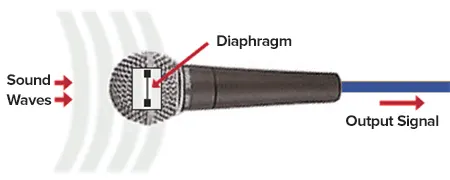
The diaphragm in the mic gets hit by these waves and vibrates at different rates and intensities. What this does is move an attached magnet over an electrical coil’s magnetic field (or acts as a second part of a capacitor) which generates a current that is directly analogous to the sound striking the diaphragm. Neat, huh?
What Else Do I Need to Record Vocals?
Here’s the catch, with a caveat that makes recording with the best vocal microphone a lot more simple than it would appear.
Preamplifier
That electrical signal is very quiet, meaning it has a very low amplitude. It needs to be turned up to line-level to get the maximum quality out of it. This boosts the signal without boosting the noise floor. This job is performed flawlessly by the best microphone preamps and less well by shoddier ones.
Please believe me when I say that the preamp you use is as important as the microphone and acoustic environment when it comes to achieving the highest quality possible.
Analog-to-Digital Converter
An ADC is the magical piece of gear that takes the now boosted and clean electrical signal from your mic and converts it to a binary digital signal your computer can understand. There’s not much more to say about it.
Some do the job better than others. Some introduce jitter, loss of data, and bad clocking, while others enhance the quality while avoiding those boo-boo’s.
Digital Audio Workstation
You’ll also need a bonafide DAW to record in. The reason you want software dedicated to the task is that you can later manipulate the recording by adding equalization, compression, reverb, and regular editing tasks. There are a ton out there like Logic Pro, Pro Tools, Reaper, etc.
“You mean I need to buy all this stuff too?” Nope. And to save the day is…
Audio Recording Interfaces
Like all other studio gear, these come in all shapes and sizes but you can’t record without one.
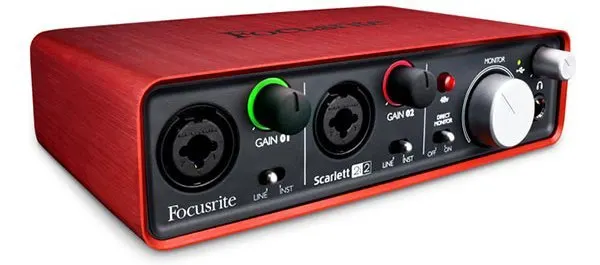
You will need an interface. You can’t just plug into your computer’s sound card because, while it does have analog-to-digital converters, it doesn’t have a preamplifier! The best audio interfaces will have very decent preamps in them, more than acceptable ADC’s, and usually come with a DAW software too. So if you thought you could just plug your new mic right into the computer… you’ll need to look at our recommendations on interfaces at the link above too.
How Do I Care For My Best Vocal Microphone?
During use, there are are three main dangers to watch out for:
- Knocking the mic over and breaking a tube or the diaphragm
- Getting spit and condensation on the diaphragm
- Exceeding the SPL limit for the diaphragm
It’s all mainly about protecting the mic’s “ear drum.” Make sure your mic stand has a sturdy base and try to route the cable in a way that it can’t get snagged and pull the whole operation to the ground. Also, wind screens and pop filters will keep spit and humidity from the human voice from reaching the diaphragm.
The pop filter will keep the vocalist far enough away to not scream the diaphragm in half. Each mic will come with a pamphlet that tells you what volume not to exceed. The reality in that you’ll have a hard time reaching the limit. Just don’t put it right in front of a guitar amp at max volume, for instance.
When not in use, you can store the mic in it’s hard shell or soft shell case that it might come with. If not, store it in any nice bag you like in a dry place with normalized temperatures. If you keep it on the stand, find a nice cloth bag that you can place over it to protect it from dust.
What Are The Two Main Types Of Vocal Mics?
The two main types of microphones used for recording vocals are:
- Condenser Mics
- Dynamic Mics
Technically, the difference is in how the diaphragm generates the electrical signal. In a dynamic, its movement passes a magnet over a coil. In a condenser, it acts as one of two parts of a capacitor, changing the distance between them to release energy.
Superficially, you can normally tell the difference because a dynamic usually points at the source of the sound while a condenser’s diaphragm faces a side of the mic. You can see both below with arrows showing what I mean, pointing right into the center of the cardioid pickup pattern:
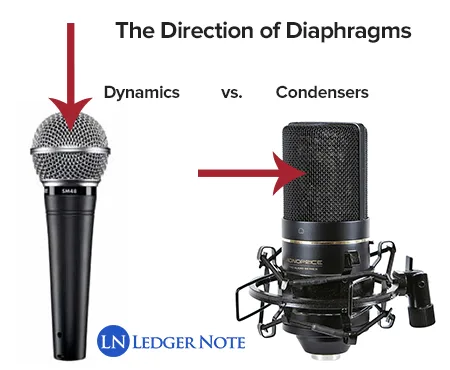
Other differences are that dynamics are typically less fragile. That’s why you see them in live concerts and speaking events instead of condensers.
They generally can withstand louder sound pressure levels without distorting or becoming damaged. Because they are less sensitive in this way, they also don’t always capture the very subtle nuances of a source.
Condensers include vacuum tubes which need to be powered. If a mic needs a special amount of power, it will come with its own external power supply. If it just needs the typical 14 volt Phantom Power, it won’t because your interface or preamp will come with the ability to supply it.
More Resources for Using Your Vocal Mic
The discussion above is the bare minimum you need to know about topics surrounding microphones for recording vocals. We can’t write an entire novel here, but if you need any more info such as how to set up your home studio, how to mix your vocals, and more, check out this selection of articles from our site:
- 14 Tips for Recording & Mixing Vocals – The Right Way…
- Recording Vocals at Home: Clean & Clear
- Vocal Warm Up Exercises for Singing
- 13 More Vocal Recording Tips
These will give you a broad overview of how to get the best performance out of yourself or client while singing, how to connect this gear to your computer, and how to clean up your audio for a professional presentation.




